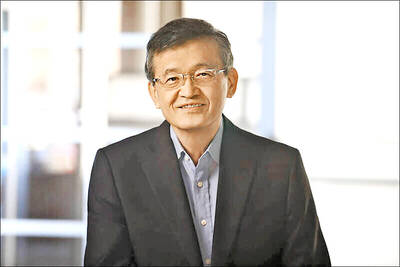After enduring endless blackouts in Nepal’s months-long and ongoing national fuel crisis, management consultant Pankaj Shrestha finally splurged on a set of solar panels for his home in Kathmandu.
“First there was no cooking gas available, so we bought an electric cooker. But then there was no electricity, so how could we cook anything?” the 52-year-old said.
With power outages lasting up to 15 hours a day and the price of diesel used to power generators soaring, the Himalayan nation’s solar industry is eyeing a boom in sales.

Photo: AFP
Although solar panels are unaffordable for millions of poor Nepalese, the industry is confident the crisis will spur the country’s frustrated middle class to invest in the renewable energy.
“We have already seen a 10 percent increase each year in the number of houses using solar energy,” said Ram Prasad Dhital, head of the state-run Alternative Energy Promotion Centre.
“But as interest develops in urban areas after the fuel crisis, we expect [the industry] to grow exponentially in coming years,” said Dhital, describing solar as “the ideal option” for many in the power-starved country.
Landlocked Nepal has historically relied on neighboring India for gasoline, diesel and cooking gas, but these and other critical supplies have slowed to a trickle since a border blockade kicked off more than four months ago.
Nepal’s Madhesi ethnic minority has blocked a key border crossing with India, in protest over a new national constitution adopted in September last year that they say denies them political representation.
Overnight lines at gasoline pumps are routine and a black market for smuggled diesel and cooking gas thrives, as government talks fail to resolve the crisis.
Until now, solar firms in Nepal have targeted rural households cut off from the electricity grid.
Non-governmental organizations and the government have subsidized sales of solar panels to more than 750,000 homes in need, but huge crowds thronged a Kathmandu trade fair on clean energy last month, with businesspeople, housewives and middle-class professionals among the mix, in a sign of changing times.
Sales of solar systems surpassed US$18 million during the three-day event, with representatives of about 90 companies struggling to keep up with demand, organizers said.
Reliable industry figures are not available, but estimates from the main manufacturers’ association suggest annual transactions total about US$140 million.
Shrestha said he paid nearly US$6,500 for the 4,200-watt solar system installed at his home last month.
“It was a very good decision,” he said. “Now we can’t even tell when the power comes and goes. We don’t have to stand in queues [either].”
Nepal receives more than 300 days of sunlight a year, more than Germany, the world leader in solar power, making it an ideal hotspot to harness renewable energy.
Efforts at solving Nepal’s energy problems have traditionally focused on tapping its hydro rather than solar potential, but a series of big-ticket projects on harnessing its Himalayan rivers for electricity have either stalled or fizzled out.
Foreign investors have long complained of red tape and other delays in getting government approval, with one Norwegian firm this month announcing its withdrawal from a US$1.5 billion hydropower project.
Nepal’s total installed hydropower generation capacity is only about 800 megawatts — 1.9 percent of its potential — despite its vast network of rivers.
“Hydropower projects are large-scale and require a lot of investment and time,” Nepal Solar Power Producers’ Association president Dipak Bahadur Shahi said.
“Whereas the solar sector is driven by the private sector and we can deliver swiftly according to demand,” Shahi said.
In recent years, small-scale solar projects have sprouted across Nepal, from dusty villages to Himalayan guesthouses that offer freezing trekkers hot showers at high altitudes.
“Earlier the demand was just for basic lighting, [but] now people want high-capacity systems that can power laptops and appliances,” Shahi said.
Solar remains too expensive for many households and businesses in a country with a per capita annual income of US$700. A basic 120-watt package costs about US$400 to power six lightbulbs and charge one laptop or a mobile phone.
However, some who can afford the investment are tired of the crisis.
Dinesh Shrestha, chair of the leading Nepalgunj Medical College, said it planned to install a solar system to power its campus of 700 students.
“It is impossible to say when Nepal’s energy crisis will be resolved,” Shrestha said. “We have spent millions on diesel generators every year. Solar is not cheap, but at least it will be a one-time investment.”

Intel Corp chief executive officer Lip-Bu Tan (陳立武) is expected to meet with Taiwanese suppliers next month in conjunction with the opening of the Computex Taipei trade show, supply chain sources said on Monday. The visit, the first for Tan to Taiwan since assuming his new post last month, would be aimed at enhancing Intel’s ties with suppliers in Taiwan as he attempts to help turn around the struggling US chipmaker, the sources said. Tan is to hold a banquet to celebrate Intel’s 40-year presence in Taiwan before Computex opens on May 20 and invite dozens of Taiwanese suppliers to exchange views

Application-specific integrated circuit designer Faraday Technology Corp (智原) yesterday said that although revenue this quarter would decline 30 percent from last quarter, it retained its full-year forecast of revenue growth of 100 percent. The company attributed the quarterly drop to a slowdown in customers’ production of chips using Faraday’s advanced packaging technology. The company is still confident about its revenue growth this year, given its strong “design-win” — or the projects it won to help customers design their chips, Faraday president Steve Wang (王國雍) told an online earnings conference. “The design-win this year is better than we expected. We believe we will win

Chizuko Kimura has become the first female sushi chef in the world to win a Michelin star, fulfilling a promise she made to her dying husband to continue his legacy. The 54-year-old Japanese chef regained the Michelin star her late husband, Shunei Kimura, won three years ago for their Sushi Shunei restaurant in Paris. For Shunei Kimura, the star was a dream come true. However, the joy was short-lived. He died from cancer just three months later in June 2022. He was 65. The following year, the restaurant in the heart of Montmartre lost its star rating. Chizuko Kimura insisted that the new star is still down

While China’s leaders use their economic and political might to fight US President Donald Trump’s trade war “to the end,” its army of social media soldiers are embarking on a more humorous campaign online. Trump’s tariff blitz has seen Washington and Beijing impose eye-watering duties on imports from the other, fanning a standoff between the economic superpowers that has sparked global recession fears and sent markets into a tailspin. Trump says his policy is a response to years of being “ripped off” by other countries and aims to bring manufacturing to the US, forcing companies to employ US workers. However, China’s online warriors